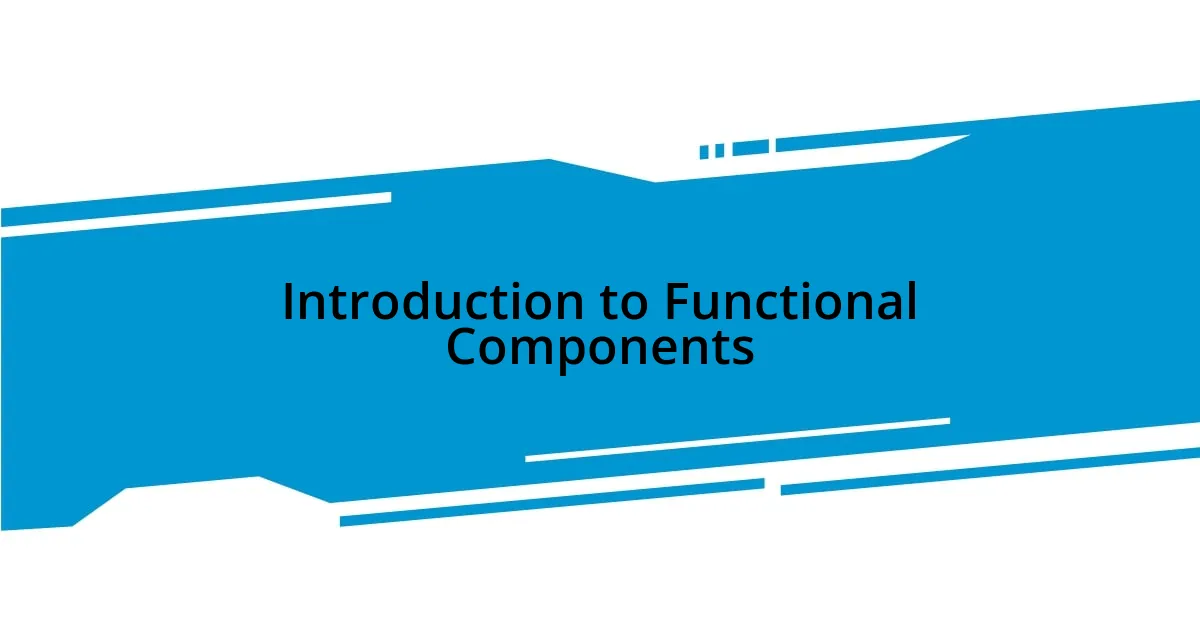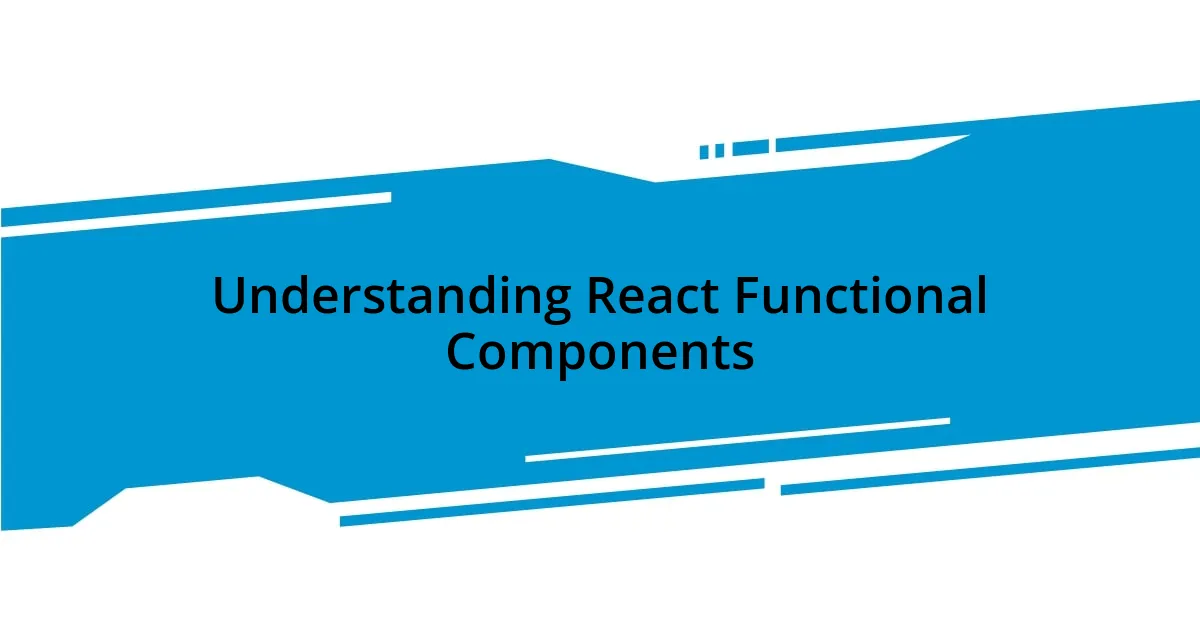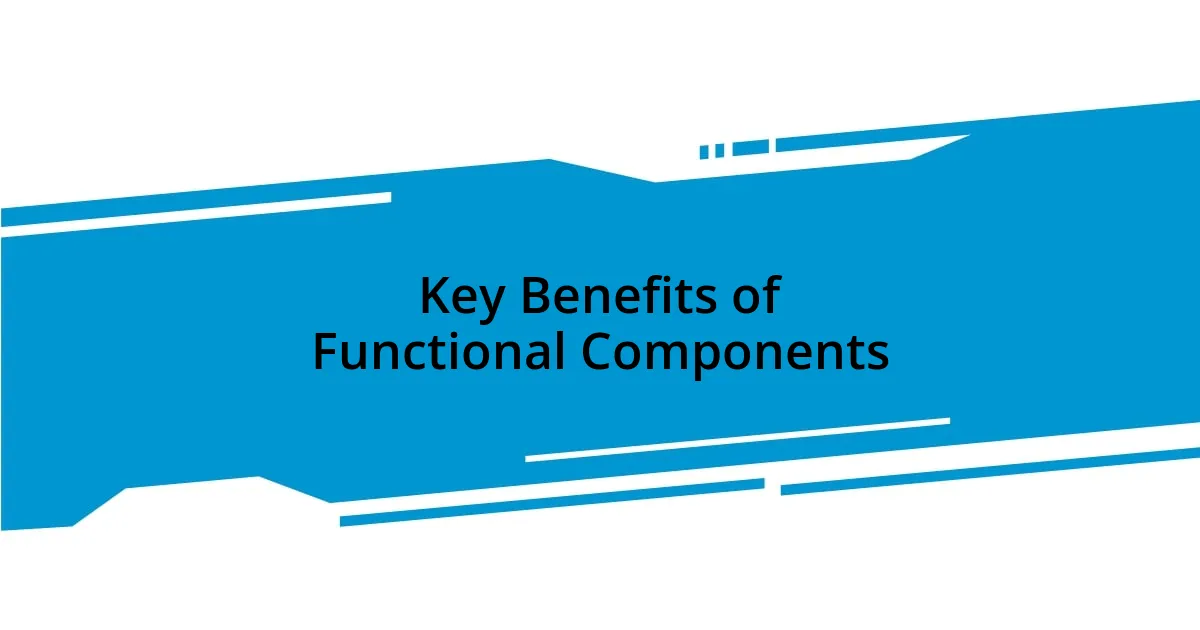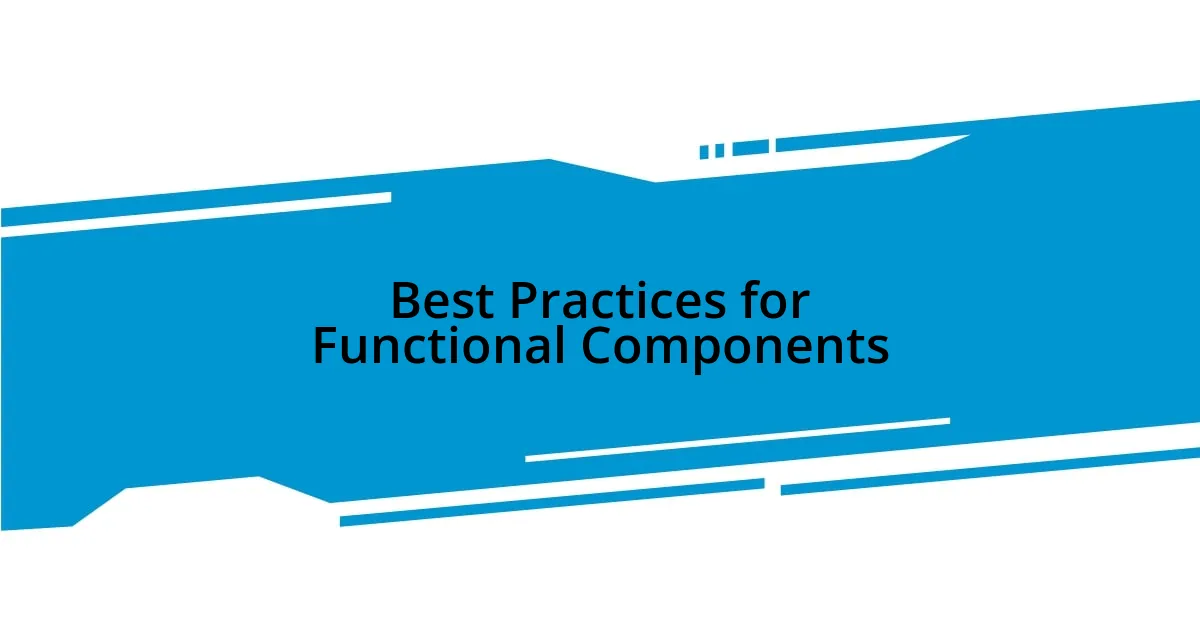Key takeaways:
- Functional components in React simplify development by allowing cleaner and more readable code, reducing boilerplate associated with class components.
- They enhance performance, reusability, and encourage writing pure functions, leading to easier debugging and maintenance.
- Best practices include keeping components small, using hooks intentionally, and implementing prop validation for better reliability.
- Common challenges involve managing state effectively, avoiding overuse of hooks, and ensuring proper testing of components and their interactions.

Introduction to Functional Components
When I first encountered functional components in React, it felt like unlocking a new layer of simplicity in web development. These components, which are JavaScript functions, allow us to define the UI without the overwhelming complexity often associated with class-based components. I remember the moment I figured out how powerful using hooks could be; it was like discovering a shortcut that significantly streamlined my code.
Functional components are fascinating because they promote a cleaner and more readable structure in your applications. Have you ever spent hours untangling convoluted class components? I sure have, and that experience made me appreciate the elegance of functional components all the more. They not only enhance performance but also encourage the use of pure functions, which can lead to fewer bugs and easier maintenance.
What truly captivates me about these components is their ability to embrace hooks, such as useState and useEffect, allowing for state and lifecycle management within the same concise format. This shift enabled me to focus on the logic of my applications rather than getting lost in the structure. It’s like realizing you can express your creativity in a canvas that’s much less cluttered—doesn’t that sound appealing?

Understanding React Functional Components
Understanding React functional components has transformed the way I approach building applications. When I first started using them, I vividly recall the relief I felt at how straightforward they are. Functional components feel much less intimidating; it’s refreshing not to deal with the endless boilerplate code often found in class components. They allowed me to write what I needed directly, which made the entire development process much more enjoyable.
Here are some key aspects I’ve found helpful when working with functional components:
- Simplicity: They enable a clear and concise way to write components without the heaviness of class syntax.
- Hooks: Leveraging hooks like
useStateanduseEffectbrought reactive programming into my toolbox without sacrificing readability. - Performance: I’ve noticed that functional components offer improved performance due to less overhead.
- Pure Functions: By promoting purity in my functions, I often find that bugs are easier to track down.
- Reusability: The way I can create reusable logic with hooks has drastically reduced code duplication in my projects.
Reflecting on my experiences, it’s clear that functional components contribute to a more intuitive and straightforward development style. The fluidity they allow opens doors for experimentation, and I truly cherish those moments when code just flows naturally. Have you had similar experiences with them?

Key Benefits of Functional Components
Functional components offer several key benefits that have significantly enhanced my development experience. One of the most striking advantages is their simplicity, which has transformed the way I structure my applications. I still recall the first time I wrote a functional component without the class syntax overhead; it felt liberating. I was finally able to focus on crafting features rather than wrestling with unnecessary complexity.
Another critical benefit is performance. Since adopting functional components, I’ve noticed my applications loading faster and responding more efficiently. This improvement not only boosts user satisfaction but also amplifies my confidence as a developer. Working with tools like useMemo and useCallback, I find it easier to optimize my components, a stark contrast to my earlier struggles with class-based performance tweaks.
The reusability factor cannot be overstated. Through hooks, I’m able to extract and share logic across components with ease, creating a more maintainable codebase. I’ve always valued good organization, and using functional components has made my code much tidier. There’s a sense of satisfaction in knowing that I’m also pushing best practices by writing pure functions. Have you experienced this shift in developing more efficiently with functional components?
| Benefit | Description |
|---|---|
| Simplicity | Clear and concise structure without class syntax overhead |
| Performance | Improved load times and responsiveness through efficient rendering |
| Reusability | Leveraging hooks for shared logic, leading to a cleaner codebase |

Best Practices for Functional Components
When it comes to best practices for functional components, one key approach I’ve adopted is to keep my components small and focused. I remember a project where I tried to cram too much functionality into a single component, and it created chaos. Breaking components down into smaller, manageable pieces not only enhances readability but also makes testing a breeze. Why complicate things when simplicity leads to cleaner code?
Another practice that has been a game-changer for me is the use of hooks properly. I recall the first time I experimented with useEffect. It was like a light bulb went off; I realized how potent it can be for side effects. However, I learned to use dependencies judiciously to avoid issues. Have you ever faced unexpected behavior because of overlooked dependencies? Trust me, staying intentional about which variables I include has saved me from countless debugging headaches.
Lastly, I cannot stress enough the importance of prop validation. Early in my journey, I neglected this, thinking it was an unnecessary step. Then I encountered a bug that stemmed from incorrect data types being passed. Once I started using PropTypes or TypeScript, it felt like a safety net had been put in place. It not only enhanced my code’s reliability but also boosted my confidence in implementing new features. Isn’t it comforting to know that your components are receiving the correct data?

Common Challenges with Functional Components
One common challenge I’ve encountered with functional components is managing state effectively. In my early projects, I experimented with useState, but I quickly realized that updating state asynchronously could lead to confusion. Once, I found myself in a scenario where my component rendered outdated values, and it left me scratching my head. Now, I always ask myself if I’m properly handling the data flow to avoid those head-scratching moments.
Another issue I’ve faced is the overuse of hooks, particularly with useEffect. I remember this one time when I created a chain of effects that spiraled out of control. It felt like I was juggling too many balls at once, and when one dropped, the entire application seemed to falter. Now, I focus on limiting the number of hooks I use and grouping related effects. Have you ever felt like you were in a similar situation, trying to manage too many moving parts?
Lastly, the challenge of testing functional components has been eye-opening for me. While the simplicity of these components is a blessing, I found that testing them often required a deeper understanding of hooks and context. I recall a time when my tests broke due to missed updates in state, which was a hard lesson learned. So now, I take the time to write clear tests for each component’s functionality to reinforce my confidence and ensure stability. How do you handle testing in your functional components?
















